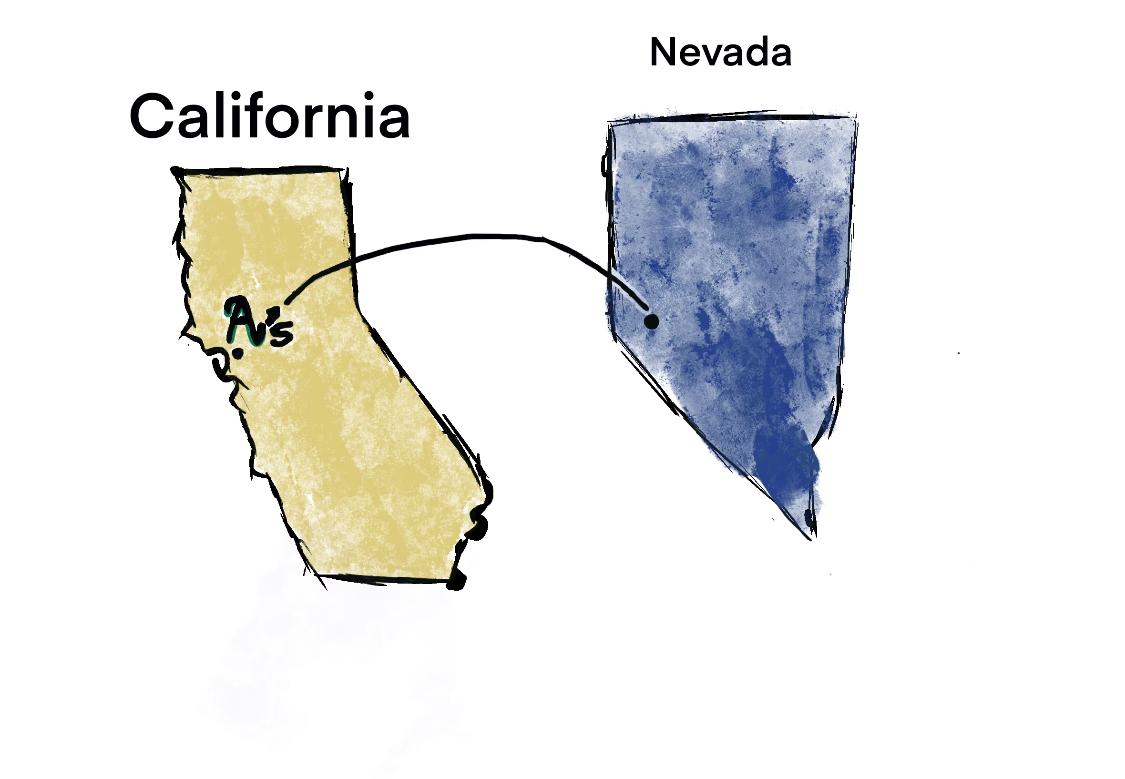In November, it was announced that the Oakland Athletics (A’s) relocation to Las Vegas was finally approved by the Major League Baseball (MLB) owners. The A’s will play out the 2024 season as their last in Oakland, before a temporary move to Sacramento starting in the 2025 season. If all goes according to plan, they will permanently move to Las Vegas in 2027. The A’s moving is not at all a new issue, however. They first applied for relocation back in 2021 — a season in which they finished well at 86-76, narrowly missing the playoffs.
But even 2021 isn’t going back far enough to get proper context for the move. I spoke to Bob Allaire, a former baseball player at the University of Notre Dame; coach at California State University, Stanislaus, and now a baseball fanatic. Allaire has lived near the Bay Area since the A’s were in Kansas City in the 60s. He told me he was “not surprised” by the relocation and that the A’s have almost moved a few times, most notably in the 1980s. He also stated, “They never had good attendance in Oakland, even in the good years [when the A’s made three World Series appearances in a row from 1988-1990].”
Attendance is one of the biggest reasons for the A’s departure. Last year, they had the lowest attendance in the MLB by a massive margin: around 500,000 fewer fans over the whole season than the second lowest team, the Tampa Bay Rays. Even before last year, which was partially exaggerated by fans boycotting, they’ve had poor attendance. In the last 10 full MLB seasons their attendance numbers were bottom five in the league, six out of nine seasons, excluding the 2020 season which had no fans due to COVID. The seasons where they weren’t bottom five were 2019, 2014 and 2013, all seasons in which they made the playoffs. However, even in these successful seasons, the attendance numbers still weren’t good, as they finished 24th, 24th, and 23rd in those seasons.
There are quite a few factors that lead to these poor attendance numbers. One of the biggest ones is the stadium they play in. The Oakland Coliseum was opened in 1966 and at first only hosted the A’s, but when the National Football League team, the Raiders, moved back to Oakland in 1995, it got a massive renovation. The renovation was made so that it could become a multi-sport stadium to host the Raiders along with the A’s.
Fast forward to recent times, the multi-sport stadium trend started to die off and the Coliseum was one of the last remaining. While it saved money not having to build another stadium, fitting a football field on a baseball field was an awkward fit simply because a football field is a massive rectangle and a baseball field is a large diamond. This led to bad seating for fans and bad field dimensions. These reasons led to this type of stadium design dying out over the years, but not the Oakland Coliseum, as they would keep the same stadium for both teams all the way until both of their departures.
Not only did they keep the stadium, but since the 90s they’ve kept it without renovation. As you can imagine this has led to the Oakland Coliseum being known as one of, if not the worst, stadiums in major American sports. There have been many issues with the aging stadium, and back in 2013, the A’s clubhouse was filled with sewage when the bathrooms overflowed due to rain. This wasn’t the last sewage related incident at the Coliseum either, as in 2016 the visiting New York Yankees dugout had to be mopped up when a toilet got too backed up. Some have called these incidents symbolic of the A’s struggles over the years.
The stadium isn’t the only reason fans don’t want to go to A’s games. One man has played a big part in all this, and his name is John Fisher. Fisher is the owner of the A’s and is currently one of the most hated people in Oakland. Since his purchase of the A’s for $180 million in 2005, Fisher has almost entirely neglected the franchise until it was time to move them. In 2005, the A’s attendance for the year was 2,109,118 and in the nearly 20 years since, attendance numbers have never surpassed that and only reached 2 million one time in 2014. Since his purchase of the team, Fisher has kept player salaries as cheap as possible, spending only $62 million on player contracts last year, which was 10 million less than the team ahead of them and $280 million less than the New York Mets. He’s built a reputation as one of the stingiest owners in the MLB. In 2005 and many years prior, the A’s were a very competitive team with lots of talent built by legendary general manager Billy Beane. But because Fisher refused to give the players the contracts they deserved, those players joined different teams where they could get paid what they deserved.
This led to the A’s being pretty bad from 2007 to 2011. However, in 2012 they won 94 games and made it to the playoffs, eventually losing in the American League Division Series. They would also make the playoffs in 2013 and 2014, and things were looking up. But before the 2015 season the young stars that led the A’s lineup, including players like Yoenis Cespedes and Josh Donaldson, were traded for prospects right before they were due for bigger contracts. Along with them, starting pitcher Scott Kazmir was traded, and just like that the A’s were sent back into mediocrity. They would finish near the bottom of the league every year after 2014 until returning to the postseason in 2018, led by players like Matt Chapman, Matt Olson and Marcus Semien. This core led them to the playoffs in 2019 and 2020, but after the 2020 season, All Star shortstop Marcus Semien would sign with the Texas Rangers. In 2021, the A’s would miss the playoffs but looked competitive, winning 86 games. However, that off season the A’s would see Chapman, Olson and starting pitcher Sean Manea all leave, causing the A’s to win just 60 games in 2022. Things didn’t get any better last season either, as they won just 50 games, finishing last in the entire MLB.
This pattern of developing great young players just to let them walk after a few seasons has made fans frustrated with the A’s organization and ownership. With a crumbling, awkward, and oversized stadium, terrible baseball team, and a neglectful owner, the people of Oakland can’t think of many reasons to come out to games. Fans have been displaying their distaste for the owner for years, most notably last season, when in a game against the San Francisco Giants, fans packed the seats for one of the only sold out games in recent A’s history, to protest John Fisher. The fans VERY loudly chanted “Sell the team!” in what the fans called a “reverse boycott.”
However, despite the fans’ protest, John Fisher does not intend to sell the team and the relocation is still very much happening. There was at one point a proposal for the A’s to stay in the Bay Area and move to San Jose, but that was blocked by crosstown rivals, the San Francisco Giants, because they felt that would damage their revenue.
The new stadium in Las Vegas that is set to be used by the A’s starting in 2027 is supposed to have 33,000 seats. This will take the A’s from the largest capacity stadium in the MLB to the smallest. I asked Jasper Fletchner, a Franklin junior and varsity baseball player, if he thinks the attendance in Las Vegas will improve. He told me, “I don’t think they’ll have much if any fans, and those that do come won’t have much passion for the team.” The stadium is set to be built on the Las Vegas Strip. Despite the much smaller stadium, it will likely have much better attendance due to Las Vegas being a much larger tourist destination than Oakland. Las Vegas technically already has a professional baseball team, the A’s AAA affiliate the Las Vegas Aviators, although fans are rarely very invested in minor league teams.
There are still many questions about the A’s move to Las Vegas. Will the team get better? Will John Fisher put more money into the team? Will they have any fans at all? Unfortunately, these questions can only be answered by time.




































Daniel Boone • Jun 20, 2025 at 7:15 am
Well I’ll certainly miss one of my all time favorite franchises. I loved the “old A’s” and it didn’t matter to me that the stadium was old. I love old baseball stadiums too. When it comes down to it I love baseball more than the stadiums and the owners.